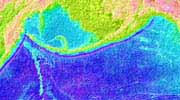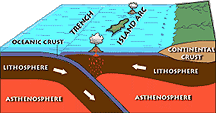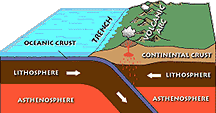
 The most volcanically active belt on Earth
is known as the Ring of Fire, a region of subduction zone
volcanism surrounding the Pacific Ocean. Subduction zone volcanism
occurs where two plates are converging on one another. One plate
containing oceanic lithosphere descends beneath the adjacent plate,
thus consuming the oceanic lithosphere into the earth's mantle.
This on-going process is called subduction. As the
descending plate bends downward at the surface, it creates a large
linear depression called an oceanic trench. These
trenches are the deepest topographic features on the earth's surface.
The deepest, 11 kilometers below sealevel, is the Mariana trench,
which lies along the western margin of the Ring of Fire.
Another example, forming the northern rim of the Ring of Fire,
is the Aleutian trench shown here:
The most volcanically active belt on Earth
is known as the Ring of Fire, a region of subduction zone
volcanism surrounding the Pacific Ocean. Subduction zone volcanism
occurs where two plates are converging on one another. One plate
containing oceanic lithosphere descends beneath the adjacent plate,
thus consuming the oceanic lithosphere into the earth's mantle.
This on-going process is called subduction. As the
descending plate bends downward at the surface, it creates a large
linear depression called an oceanic trench. These
trenches are the deepest topographic features on the earth's surface.
The deepest, 11 kilometers below sealevel, is the Mariana trench,
which lies along the western margin of the Ring of Fire.
Another example, forming the northern rim of the Ring of Fire,
is the Aleutian trench shown here:

|
The Pacific plate descends into the mantle at the site of the Aleutian trench. Subduction zone volcanism here has generated the Aleutian island chain of active volcanoes. Courtesy of NOAA. |
The crustal portion of the subducting slab contains a significant amount of surface water, as well as water contained in hydrated minerals within the seafloor basalt. As the subducting slab descends to greater and greater depths, it progressively encounters greater temperatures and greater pressures which cause the slab to release water into the mantle wedge overlying the descending plate. Water has the effect of lowering the melting temperature of the mantle, thus causing it to melt. The magma produced by this mechanism varies from basalt to andesite in composition. It rises upward to produce a linear belt of volcanoes parallel to the oceanic trench, as exemplified in the above image of the Aleutian Island chain. The chain of volcanoes is called an island arc. If the oceanic lithosphere subducts beneath an adjacent plate of continental lithosphere, then a similar belt of volcanoes will be generated on continental crust. This belt is then called a volcanic arc, examples of which include the Cascade volcanic arc of the U.S. Pacific northwest, and the Andes volcanic arc of South America.

|

|
|
oceanic-oceanic subduction |
oceanic-continental subduction |
The volcanoes produced by subduction zone volcanism are typically stratovolcanoes. Incipient island arcs tend to be more basaltic in composition, whereas mature continental volcanic arcs tend to be more andesitic in composition.
Go to: